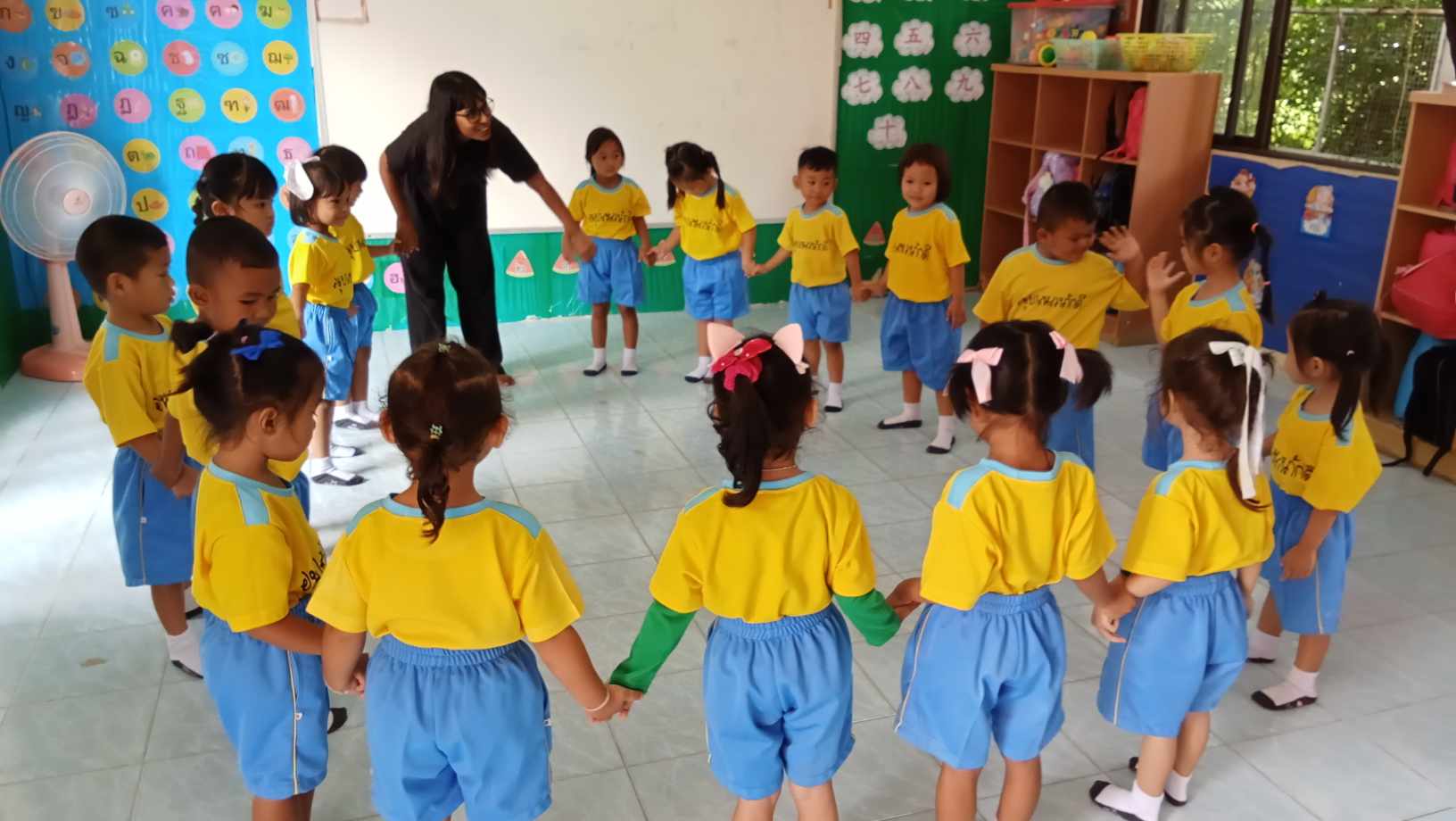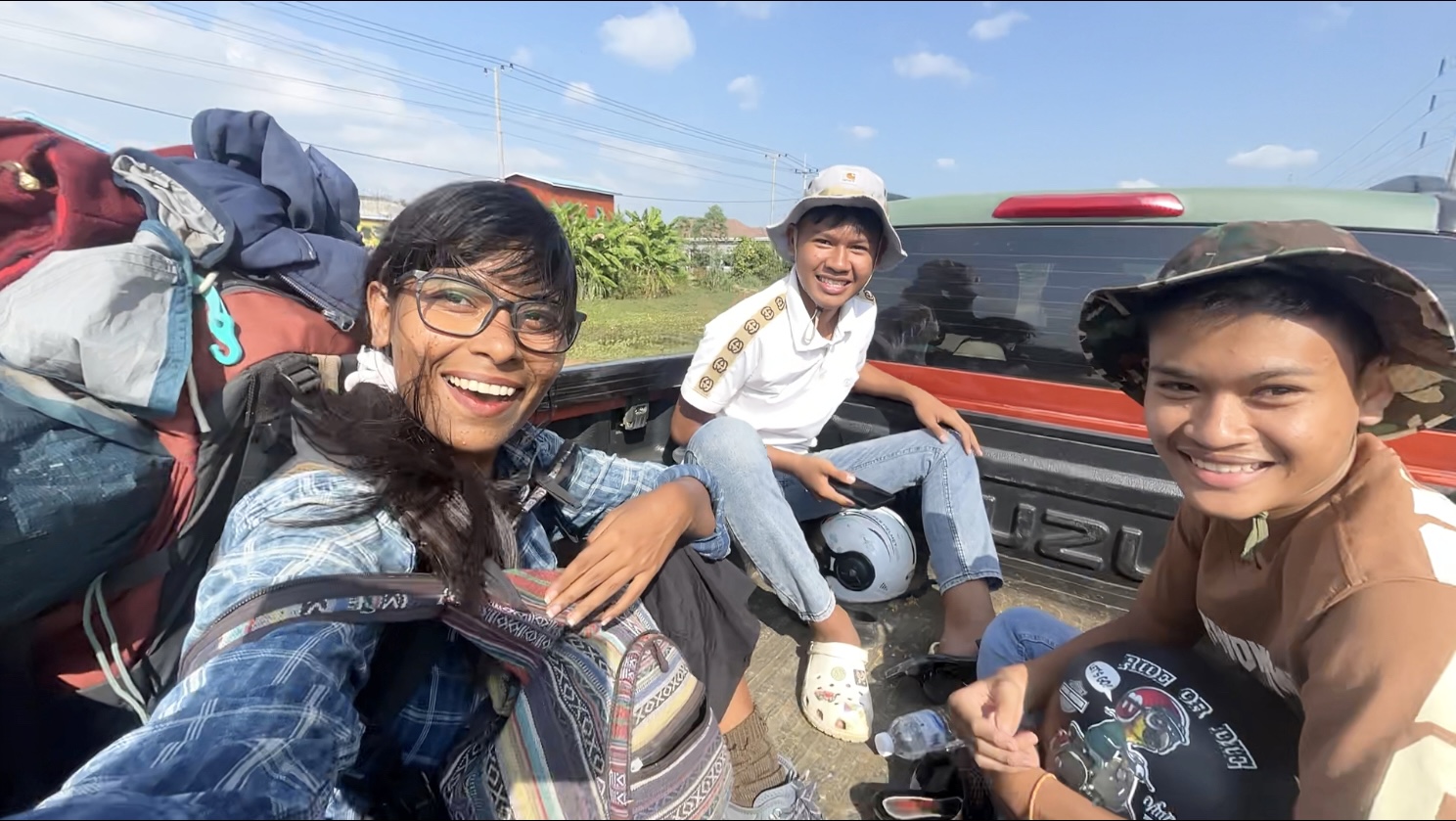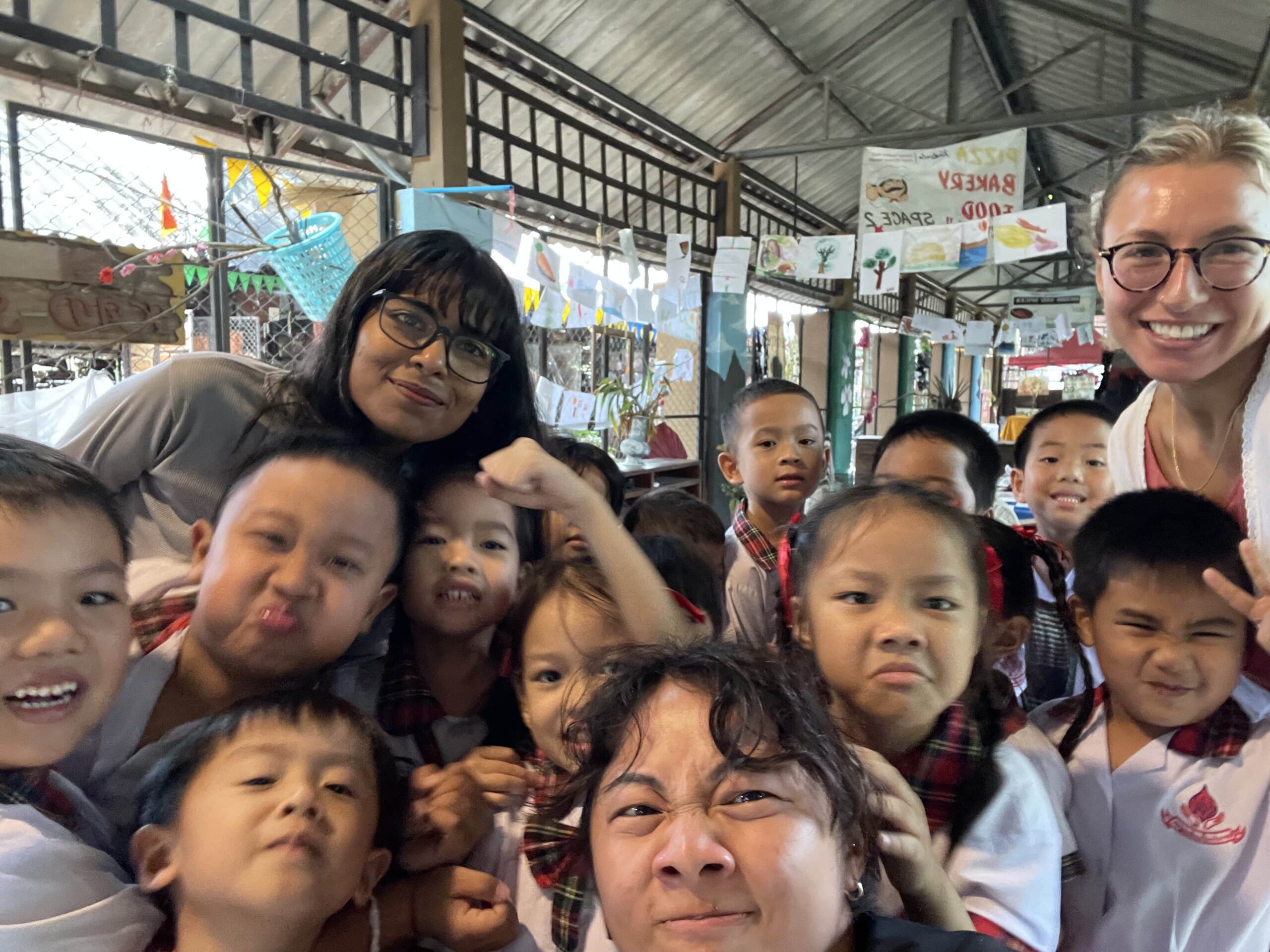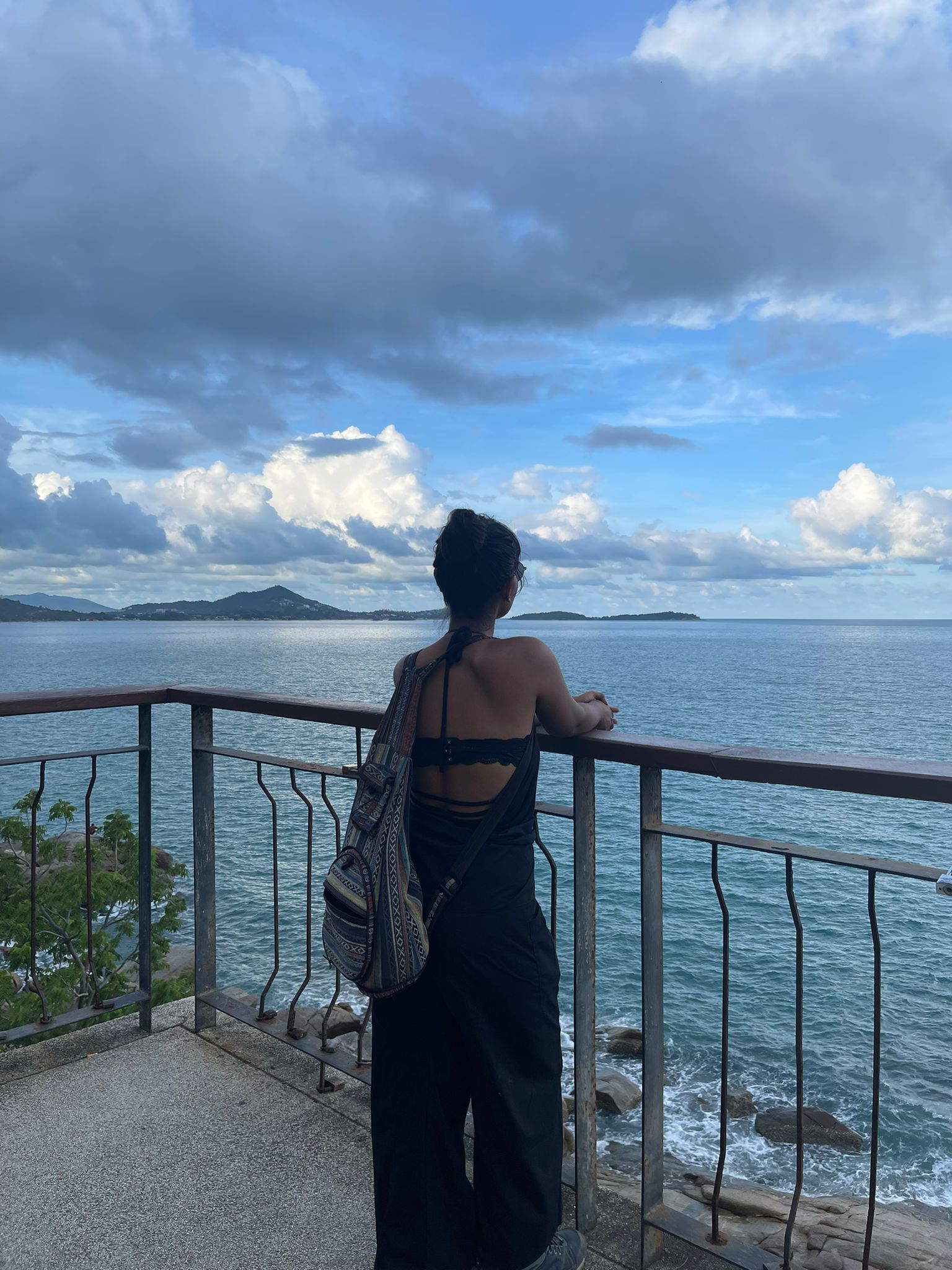A sensory walk through a tiny Thai village named Ban Khwao, with nothing to see, and everything to feel, with homemade Thai food, faces and laughter, as I volunteer for two weeks in a school in Chaiyaphum’s Ban Khwao.
I crack the crust of sunflower seeds from the left clench of my teeth, feeling the salt sprinkled on the sheen. ‘C-r-a-c-k!’ A sound that tosses off its last syllable under the open tongue. The buttery seed comes off. For every tiny seed, the crack needs a bit of teething; to push the momentum and the uncertain pressure, to save the falling seed over the palm lines. The hard outer part has a soft brown border in its wholesome blackness.
The simple act of eating sunflower seeds may seem mundane, but that’s what Ban Khwao is; a parody of the expected ‘conventional beauty’. A mindful observatory in its row of flat-end houses, in the east and west bylanes posturing the periphery of a lake. Houses, shops, and a lake. No more, no less. What more, what less?

The chosen elements have the capacity to master how settled a place would be on our senses. What are the chances that Tim’s sister’s house was just around the lake? I wouldn’t have felt the same if I were in some other part of Ban Khwao. Grounding often needs the extraordinary power of external silence in green nature and internal affection.
Ban Khwao And My Observations around the Kindergarten School
Hair is parted on the wavy side, touching the nip of her ears; like the ocean wants the shore, with come-and-go provocations, never to settle with promises. Her eyes squint in crumpled vibrations through the light-brown eyeballs, in a dollop of innocent wonder scurrying off; rushing out of her 67-year-old identity. The eyes speak Thai; the cheekbones, curled dark-red lips… ‘Sawadikha-a-a-a…’ Madam Um bows her head in folded palms, in discipline, a greeting gesture in Thailand.

Fridays in school are for traditional Thai clothes. Madam Um has a red half-sleeved blouse on; a shade darker than the darkest cherry, and a Thai long skirt with a bi-folded cut surfacing the middle. She has paired it with a multi-coloured bead-necklace and the same ornamental waist-chain in a knot. The last bead hangs just above the rim of her blouse. I compliment her on the outfit. Her high-toned laugh soared, ‘Thank you-u-u-u!’ The tone stretches high,high,high… Until it elopes with the bursting dance beats from the school speaker.
But curiosity and mindfulness always find a chafing consonance within our own soul elements, no matter where we are physically, even around a lotus that was never there; now there, a wonder.
Time to show the dance moves. The welcome song, the funky up-close Thai beats that shake your waist, the mellow voice of a man singing ‘Sawaee Sawaee’ in aesthetic meditation… Half an hour of prayer duties for the kindergarten kids. The singing, dancing and laughter bypass the narrow edges of the front balcony, the pack of mafia dogs, and blow away as far as the faraway red Buddhist shrine in Ban Khwao; even making a round around the coconut at Buddha’s immobile feet. The ABCDs, 1234s, lower-upper cases, heads of lions, stems of roses and red apples disappear around the little Thai faces, like butterflies they can’t spell. And after two hours of fooling around with the teachers, the kids sleep on babyproof mattresses, habitually falling asleep for 2-3 hours. This is a school where sleeping is on the academic calendar. On a potentially larger mattress, the teacher dozes off right beside.

I had my doubts about working with 5-year-old kids, but I took it rather as a flow; a flow that I have shouldered and carried over my back as it is. I have taught in numerous schools before as a volunteer, but I prefer students more at a mature age to have more constructive conversations, where I can delve more into literature, debates, environmental understandings, and the process of writing. Kindergarten kids? Oh, that’s a whole other skill!
Colours Change But Things Remain the Same
August speaks up in an accent, unusual for a typical non-native English-speaker of 5, ‘My dog is in heaven now. He died and went to heaven.’ The accent confuses me, and also the full-sentences he was making in English. ‘His grandfather is British! He is a Thai boy though, not a foreigner-boy. His grandmother’s son from the first marriage had August with a Thai woman. But he spends a lot of time with his grandfather.’ Tim tells me over our daily lunch in local food joints around Ban Khwao. For some reason, I want to remember him. And also Wai Wai, Khup Kha, Pinto…

‘Can you give me 15 minutes, Teacher Eve? The students are coloring some drawings for an important Buddhist day.’ The level 3 teacher shows me on Google Translator. Interactions in Ban Khwao are often through Google Translator; even the 7-11 store guys almost always just put my head against the record button. My name has unlayered in no time, at the same pace as an alligator’s changing colour. A smooth downfall from ‘Ip’ to ‘Eve’. Teacher Eve. That’s me.
The simple act of eating sunflower seeds may seem mundane, but that’s what Ban Khwao is; a parody of the expected ‘conventional beauty’.
Thailand also changes its colour. The Hindu astronomical chart has assigned a colour on each day considering the symbolisms of Navagraha; a Hindu way of configuring nine deities that influence human life on Earth. On Mondays, yellow; the King’s colour. The present king of Thailand, Vajiralongkorn, the tenth monarch of the Thai Chakri dynasty, was born on a Monday. His flag is yellow, flung all over the country, on the advent of his birthday on 28th July. The Queen’s colour is purple. And Thailand’s day-to-day colours are reflected in Thai clothes in Ban Khwao’s schools; in the teachers, the students. Tuesday is pink (Mars), Wednesday is green (mercury), Thursday is orange (Jupiter), Friday is light blue (Venus), Saturday is purple (Saturn), and Sunday is the colour of red, for the Sun God!
Also read – How to Cross the Malaysia-Thailand Land Border by Train

The images have different movements, but I know exactly how the hours would pan out. The sequence of the songs, the moves, the kids eyeing the dancing leads and impersonating the flashes of moving wrists… I know Tim would ask them to lift up their right arms and repeat ‘See you later.’ Her heavy Thai accent makes every sentence a tub of poise and comedy, as if she speaks from the womb. I know the routine, the preview; but from a corner step, I laugh at the new laughters from an old routine. The Thai laughter that restarts in the spree of old engines, but keeps the gaps riddled in the long-boiled intonation.
Thai Food in Chaiyaphum’s Ban Khwao
‘You will have lunch with me’, My host Tim told me the first day. Her ‘supercar’ is a green electric two-seater, a mini and aristocratic (and slimmer) version of the South Asian tuk-tuk. More open space makes way for more wind; more so an amusement park-ride around Ban Khwao. We go to her brother’s Noodles Shop one day, then a Som Tum Salad (Green Papaya Salad) accompanies Khanom Chan and Nam Khao Tod (Orange crunchy Sticky Rice salad), Glass Noodles from another lunch expedition to a tiny Thai kiosk.

Tim cooks dinner for me; too big to finish. A big bowl of vegetable stew or a pumpkin ensemble; which I suspect had the whole pumpkin cooked just for one meal. The soft edges of the mouth brush over the temping taste of a special sauce they use in most Thai preparations, and even the Rice-Egg-Vegetables trio claims a new sensation. ‘I will teach you how to cook bean sprouts. Thai style!’ Tim sounds determined. But that couldn’t be. On a day she prepared the vegetables to teach me Thai cooking, three other grandmothers swooped in a luxury car wearing their cool jazzy hats and kidnapped me to Soi Thong National Park.
She hugs Tim; the woman selling the rose-shaped covers of a Thai dessert, packaged in perfection with banana leaves on a Ban Khwao moving stall. I unpack the leaves sewn with a needle-like bamboo stick, and the white Khanom Sai Sai with its sweet coconut trifold bursts into a salty-sweet texture on the tongue, melting awry with my saliva. ‘Sap?’ (‘Delicious?’) Tim asks. ‘Very Sap.’
Also read – Roadtrippin’ around Chaiyaphum with Four Thai Grandmas

But the houses and the lake are still, permanent. A red or yellow shoulder-high shrine devoted to Lord Buddha, the triangular front-shapes, the usual cheap food stalls, or a time-bound truck with its overcarrier of watermelons – Ban Khwao is no ‘wonder’. There is nothing to ‘see’. No mountains, no beaches, no anecdotes of Thailand’s tourism beauty. Then what’s there?
The tide-and-lows of laughter.
Tim And Amiyo Showing Me Around A Date Farm
Just before my idea of Ban Khwao could limit itself, the skeleton roads took up a dirt road-track, the red of the soil vaporing the air around the tires, two rows of farmlands carried on with its yo (fishnet) over the muddy fish ponds. We were a little outside of Ban Khwao; where Amiyo, Tim’s daughter, had planted faiyum trees around a squared pond. The middle has nickles of red stones, almost lying like one giant fish, pulverized. ‘You come back in 10 years, and you will see the faiyums on my tree. Thai faiyums have a huge demand in China’. The fishes create round roundabouts on the water, as the periodic wind fades through the tin-shack and curls up in the water bubbles. Amiyo pours fish-food from a large packet on the pond.

Amiyo’s daughter runs to the last rock; I could hear the shutters in repetition, in too close frequency; her brother taking his sister’s pictures. The wind knocks me over. ‘And this is saak, this will grow up to be a big tree, like that one.’ Amiyo points at the tree on the other side.
Only before, Tim and Amiyo drove me to the outskirts of Ban Khwao, to a date farm called Chaiyo Farm. ‘What’s your name?’ I ask the man in his red shirt and a Thai long farmers’ hat, smoothened in the lower flap touching the neck. The rest makes lion’s manes around his face. ‘My name is Chaiyo, like the farm.’ ‘What does it mean?’ Hooray. Chaiyo.
‘It takes 3 years for the date plants to grow, from the time of sowing to giving fruits, and getting them ready to be sold in the market. In Thailand, we only grow Barhi. There’re other kinds of dates, mainly wet dates, they grow in Tunisia, Iraq, Iran and Egypt. But in the Tropicana of Thailand, only barhi. Dry dates.’ We strolled around the date palm trees; many branches covered with yellow sacks hiding thickets of yellow dates hanging in density.

What is there in these conversations? So isolated, and vague! What is isolated? What is vague? Does beauty always have to be an outworldly external stimulation? Ban Khwao is no Chiang Mai, or Koh Samui; but curiosity and mindfulness always find a chafing consonance within our own soul elements, no matter where we are physically, even around a lotus that was never there; now there, a wonder. The withered white flowers get stampeded on my way to school; the flowery smell that intrudes my nostrils, at my pre-ordained footsteps. I need both; the internal and the external. I need Pathama Wat and its dragon temple-railings. I need my yoga mornings.
Then there is Grandma Tim’s ‘supercar’, Madam Um’s ‘Have a good life, my baby’, the kids’ incessant goodbyes, the Thai laughter over bowls of Khao (rice) and noodles, and Sawadikhaaaaa…
If you want to volunteer in Thailand’s Ban Khwao in Chaiyaphum and work with these tiny kids, don’t hestitate to reach out to Teacher Tim through Workaway.
How do you perceive beauty in cultural vibrations?
Support my solo adventures around the globe by joining the Patreon community!
Live the Adventure
Get weekly articles delivered to your doorstep and stay up-to-date with my new travel stories.





Leave a Reply